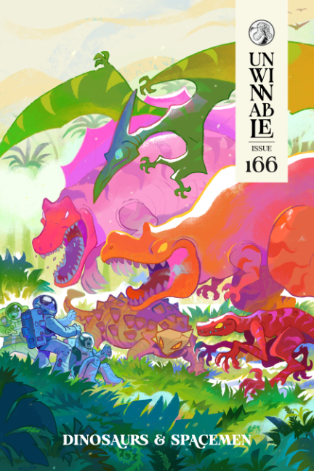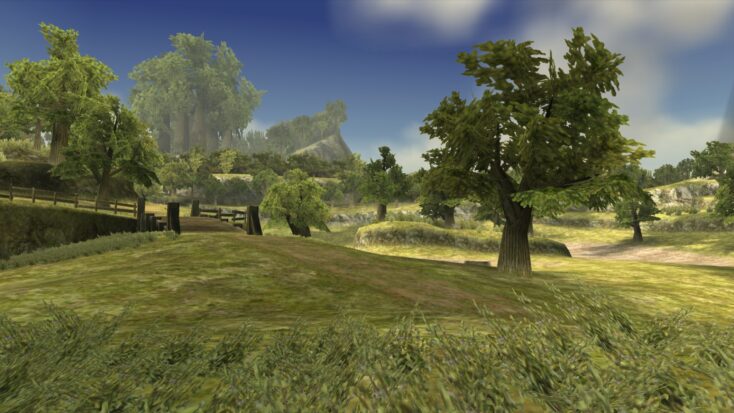
Object Lessons #1: Field

This column is a reprint from Unwinnable Monthly #166. If you like what you see, grab the magazine for less than ten dollars, or subscribe and get all future magazines for half price.
———
What’s left when we’ve moved on.
———
I’ve been writing this column for a year and a half now. That’s not such a long time, but lately I’ve been feeling it’s gotten a little unfocused, like a spiral maze someone got tired of constructing. Therefore, I want to get back to basics for the next couple months by running a sub-column where I consider a specific object, very closely, and think about how it shows up in videogames. To start us off, this month I’m writing about fields: the prototypical open spaces, digital and otherwise.
Art critic and novelist John Berger wrote an essay about the field next to his house, which he crossed occasionally to catch the train. Why, he asks, does he only cross the field when the other path is closed, despite loving it so much? His answer is that the field is a container for things to happen where “an experience of disinterested observation opens in its center.”

Berger goes on to describe what makes the ideal field for this emotion. Most importantly, it must have a boundary, “yet within the area there should be a minimum of order, a minimum of planned events.” This quality allows him to then talk about the progressive growth of attention: “Often the first experience which fixes your attention is more obvious than the subsequent ones. Having noticed the dog, you notice the butterfly.”
Turnfollow’s newest game Before the Green Moon interprets the field in a way that Berger might appreciate. As an explorer waiting to go to the moon on the next cycle of visitors, you have to plant a few crops every day and spend the rest of your time wandering around the neighborhood constructed under the astronauts’ base. There’s your house, your neighbors’ houses and a mountaintop, as well as a lake for fishing and several roads. But there are other areas I spent minutes rummaging around failing to find their purpose.
For example, there’s a field at the top of the map that serves as a hallway between your farm and the elevator going up to the spaceship. Apart from one other person and some ruins, it’s made up of a bunch of tall grass, which you can get lost behind. At least to the point that I’ve made it, there are no secrets in that grass. The field itself bleeds into a canyon and a group of pine trees, to the point that I almost feel uncomfortable calling it a field at all, but there’s not a good name for it otherwise. The question then becomes what the purpose of the space is: here, to elaborate the possibility (not realized) of secret items and give you a few real discoveries (the presence of a cave, the way the grass looks as the light changes) to keep with you as you explore around.
Fields are, first of all, unremarkable. Unnamed fields in games are numerous, from the dry grasses of Red Dead Redemption’s valleys or the world map green squares of Final Fantasy or Dragon Quest. They are qualityless to the point that a green field is its own kind of “zone,” in contrast to the fire area, the desert area, the frost area, et cetera. (Another quality Berger requires for the field to evoke attention is that it must not be winter.) The field is defined by what it doesn’t contain: serious danger, elemental qualities.
Of course, with games specifically the word has another meaning: field of vision refers to “the extent of the game world that is seen on display at any given moment” (thanks Wikipedia for that definition). And there are literal fields built on this abstract field concept, where you’re always constantly aware that what you’re seeing isn’t the full picture.

This is exemplified by the most famous of the famous game fields, Breath of the Wild’s Hyrule Field, which made the previous contender for most famous of the famous fields (Ocarina of Time) feel compact and even simple. BOTW’s environments have many of the qualities Berger ascribes to the field. They are stages where two stimuli come together (a monster frightens a deer; a digital butterfly bounces off your retinas). They have the actual potential for things to happen at any time. Even when you know the range of what those things can be, and even on occasions when those things don’t happen, the possibility makes every new location more exciting to be in. In fact, the Great Plateau is even more of a Hyrule field than the field itself is, if the field is usually a place to learn how this iteration of the world works (and if it needs to have extremely well-defined borders). In this light, every location is an extension of the plateau’s explorative possibility, while the field’s own possibility is reserved (thanks to Guardians) for most people until the very end of the game.
In turn, Tears of the Kingdom superseded its predecessor, returning Hyrule Field to an unexpected, unmoderated expanse. It’s once again the first or second area you encounter, and whether or not you choose to stay, it impacts your expectation for the rest of the game’s areas to be just as dense as the first. At the same time, the field is full of challenges ranging from beginner (find a man’s horse) to seemingly expert (explore the bottomless pit). It contains the first comforting town you see and is neighbors with the scariest interior, the castle.
In contrast, Twilight Princess’s Hyrule Field is notoriously empty. Quintin O’Connor recently called it “negative space,” more of a wheel with spokes that lead you to a destination than an attraction in itself. Youtuber Any Austin describes it as “very small but bigger.” It certainly has clearer boundaries than BOTW’s Hyrule Field does, either invisible walls or visible bottomless gorges. The recent surge of interest in Twilight Princess’s interpretation of the space is probably down to hype pre-release of Tears of the Kingdom. But both these pieces answer the question of why it works for some people even post-Breath of the Wild sea change in the same way. Both of them describe it as a place that leads to other things, not encountered purposefully, not a place where “anything could happen” but a place where very little does.
“At first I referred to the field as a space awaiting events,” Berger writes. “Now I refer to it as an event in itself. But this inconsistency parallels exactly the apparently illogical nature of the experience.”

While I was looking at opinions on Hyrule’s most central space I came across Tevis Thompson’s blog post, “Saving Zelda”. Its central argument (every Zelda since the first has been on a downward trajectory) is demonstrated through a series of desirable premises from the first few games that the author hopes will return: unmarked bombable walls, for example, are a source for player creativity rather than frustrated repetition. I disagree, and anyway the essay almost prophetically predicts Breath of the Wild, which solved the linearity problem it discusses. However, the essay’s argument against puzzle-box spaces concludes with this note: “A world is more than a space, more than a place; it is something to inhabit and be inhabited by. What you infuse a space with to make it habitable, to make it memorable (since memory is profoundly spatial), gives the place its character, its soul.”
Are fields a stage for action to take place on, or are they the action themselves? I’m most partial to the third option, the Twilight Princess approach, and the one Berger introduces only to discard in favor of field-as-event. Empty-ish fields make obvious the absence of a visual puzzle or a designed set piece. You’re forced to find ever-smaller pieces of the landscape to pay attention to. This isn’t to say I find these fields the most interesting to inhabit, but conceptually they’re the most interesting to me. They’re the places where the player has to realize that the qualities the landscape does have aren’t puzzles or rewards, but flourishes designed to make the space feel real. Sometimes, real is boring, or empty.
Fields in games are manufactured in that they’re built to mirror real spaces and in that (like real world fields) they’re defined by what’s outside them. Sometimes this means they become the background to more interesting things, sometimes they introduce events that link with the space, and sometimes they do nothing at all. And as much as I want a worthwhile experience when I play, as much as I like always understanding what a space is trying to get me to do, spaces with no clear purpose make me pause and find the answer to why I’m there for myself.
———
Emily Price is a freelance writer and PhD candidate in literature based in Brooklyn, NY.




